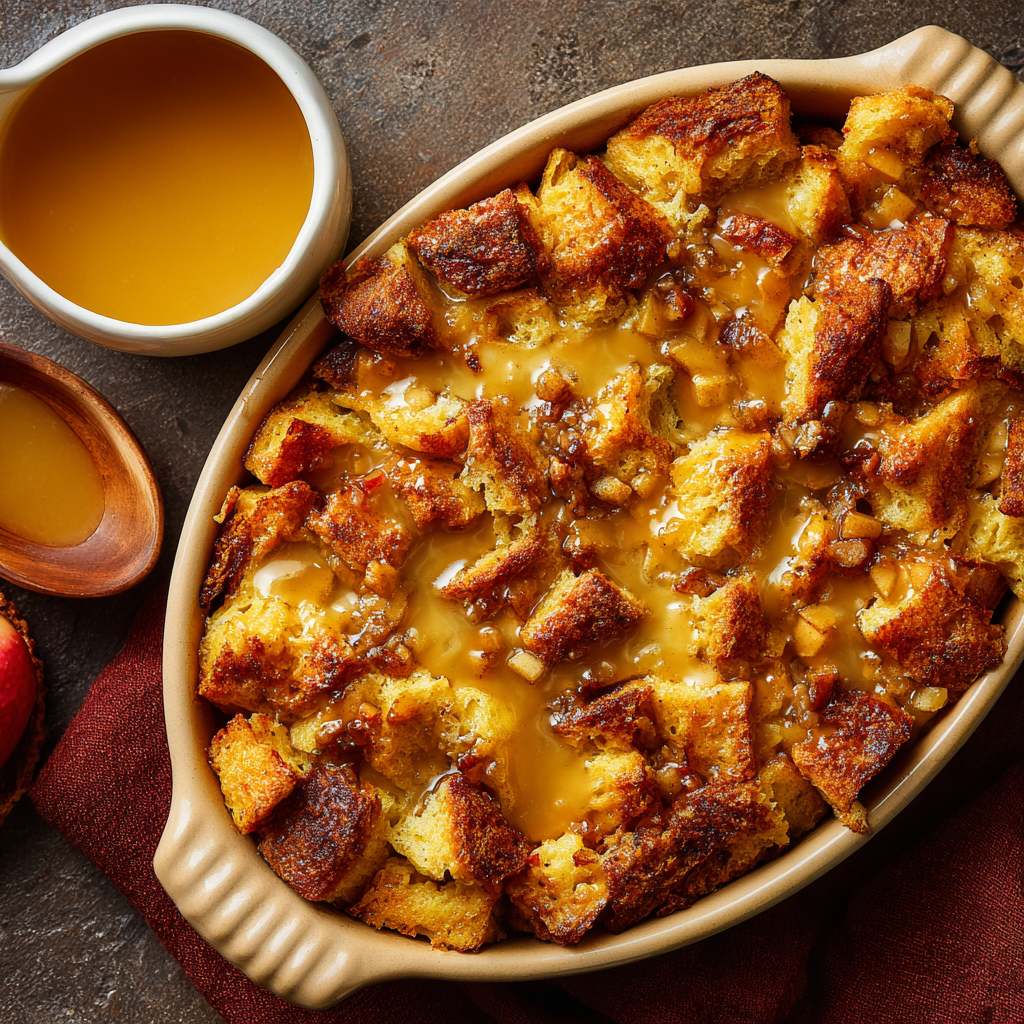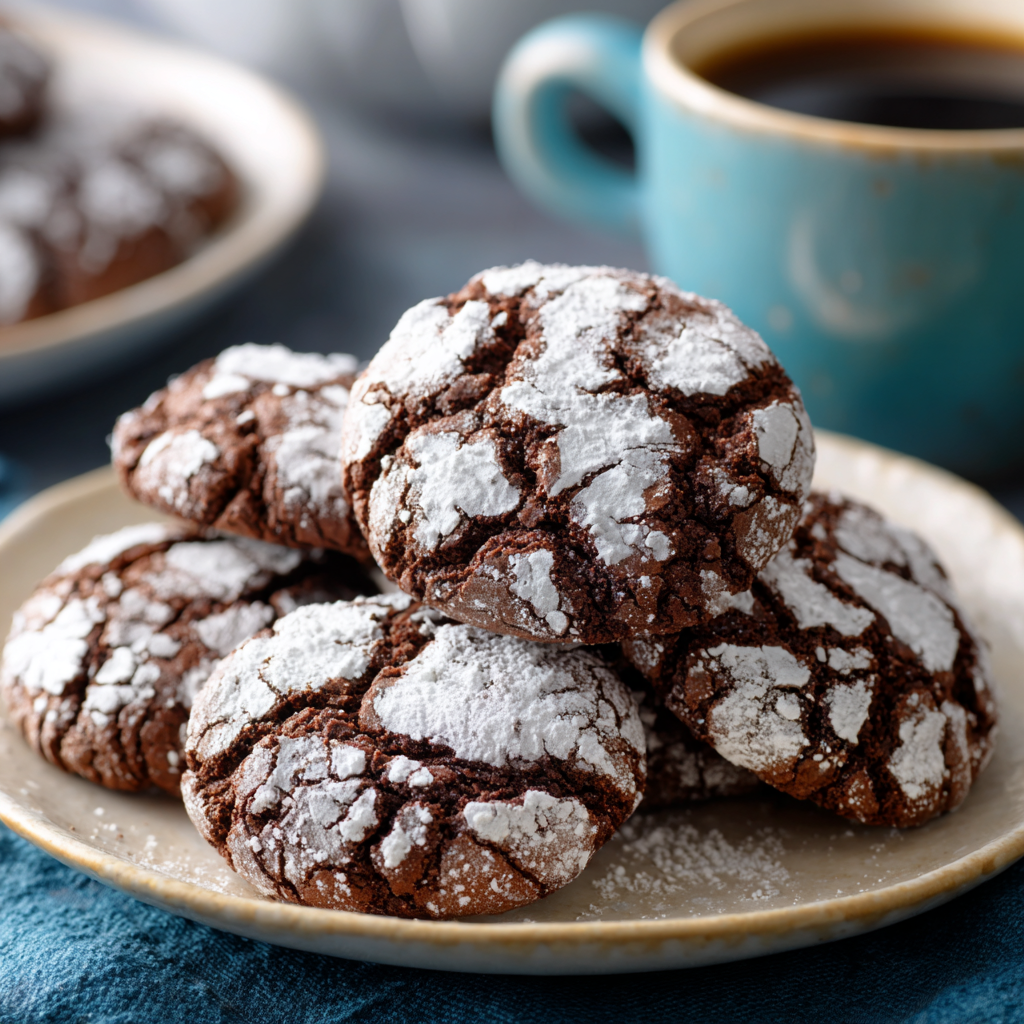Welcome to My Cozy Fall Kitchen!
Hey there, friend! Olivia here, apron slightly dusted with cinnamon and probably a smudge of maple syrup on my cheek. Can you smell that? It’s the warm, spicy-sweet scent of fall wafting through my kitchen, and it’s all thanks to my absolute favorite breakfast miracle: Apple Cider Overnight French Toast Casserole. If you’ve ever wished you could bottle up autumn mornings—crisp air, golden light, and that feeling of pure comfort—this dish is your magic wand. Picture this: fluffy bread soaked in a spiced apple cider custard, transforming overnight into a caramelized, pudding-like hug on a plate. No fancy skills needed, just a loaf of bread and that joyful “aha!” moment when you pull this beauty from the oven. Whether you’re hosting brunch or treating your crew to a slow Saturday, this casserole turns “just breakfast” into a memory-maker. Let’s dive in—I promise, your future self (sipping coffee while this bakes) will thank you!
The Apple Orchard Epiphany
This recipe? It’s pure nostalgia with a side of happy accidents. Years ago, my family visited a Vermont apple orchard on a leaf-peeping trip. We returned home with gallons of fresh cider and a craving for something warm. I’d planned classic French toast, but—plot twist!—my toddler decided midnight was party time. Exhausted, I dumped everything into a dish, shoved it in the fridge, and prayed. The next morning? Magic. That casserole emerged puffed and golden, filling our kitchen with a scent so cozy, my husband declared it “autumn on a fork.” Now, it’s our first-day-of-fall tradition. Every bite tastes like crunchy leaves, flannel shirts, and that giddy feeling when you find the perfect pumpkin. It’s not just food; it’s a time machine to joy.
Your Autumn Flavor Toolkit
Grab these simple stars—each one’s a fall MVP! Pro tip: Measure everything the night before for stress-free assembly.
- 1 loaf French or challah bread (stale!) – Chef’s insight: Stale bread soaks up custard like a dream! Challah adds buttery richness, French bread gives structure. Swap: Brioche or gluten-free sourdough.
- 4 large eggs – Chef’s insight: Your custard’s backbone! Room temp blends smoother.
- 1 ¼ cups apple cider – Non-negotiable! Reduces to intensify flavor. Swap: Apple juice in a pinch (add ½ tsp cider vinegar for tang).
- ¾ cup milk – Whole milk = luxury texture. Dietary swap: Almond or oat milk work great!
- ¼ cup maple syrup – Secret weapon: Use dark grade for caramel notes. Swap: Honey or brown sugar.
- 1 tsp cinnamon + ¼ tsp nutmeg – Pro tip: Freshly grated nutmeg? Game-changer.
- 1 tsp vanilla extract – Balances acidity. Always use pure vanilla!
Let’s Build Your Brunch Masterpiece!
Ready for the easiest “wow” moment ever? Follow these steps—I’ve tucked in all my kitchen hacks!
- Prep the Base: Grease a 9×13-inch baking dish with butter or non-stick spray. Cube your bread into 1-inch pieces—slightly uneven is fine! Chef’s hack: Spread cubes on a baking sheet for 20 minutes if not stale. Toss ’em in the dish like confetti!
- Whisk the Custard: In a big bowl, whisk eggs until yolks and whites are BFFs. Pour in cider, milk, maple syrup, vanilla, cinnamon, and nutmeg. Whisk until it’s smoother than a jazz playlist. Pro tip: Taste a drop! Adjust spices if needed.
- Soak & Dream: Slowly pour custard over bread. Gently press down with a spatula—think “tucking in a blanket,” not squishing! Every cube should blush with liquid. Cover tightly with foil. Refrigerate overnight (8-12 hours). Chef’s secret: Rotate dish once if your fridge slopes!
- Bake to Golden Glory: Next morning, preheat oven to 350°F (175°C). Remove dish from fridge while oven heats—20 minutes avoids thermal shock! Bake UNCOVERED for 40-45 mins. Doneness test: Center should spring back lightly. Edges will be crisp and caramelized!
- Rest & Revel: Let casserole sit 5-10 minutes before serving. It deflates slightly (totally normal!), making it easier to slice. Emergency hack: If top browns too fast, tent loosely with foil.
Plating Like a Pro (Zero Effort Required!)
Slide a spatula under a generous square—custardy middle, crispy edges. Dust with snowy powdered sugar or drizzle with warm apple cider syrup (simmer 1 cup cider + ¼ cup maple syrup until thick!). For texture, scatter toasted pecans or sautéed cinnamon apples on top. Pair with hot coffee, a dollop of whipped cream, and big smiles. This dish shines family-style: plop the whole dish on the table and let everyone dig in!
The Science of Soaking: Why Overnight is Everything
You might be tempted to mix this casserole and pop it straight into the oven. I get it—the anticipation is real! But, my friend, the magic of this dish isn’t just in the ingredients; it’s in the wait. That overnight rest in the fridge isn’t a mere suggestion; it’s the alchemical process that transforms a simple bread-and-egg mixture into a sublime, custardy masterpiece. Let’s geek out for a moment on the beautiful science happening while you sleep.
It all starts with the star of the show: the bread. Stale, dry bread is not a mistake; it’s your secret weapon. Think of a day-old loaf as a thirsty sponge, its starch molecules having crystallized and hardened. When you pour that rich, spiced apple cider custard over it, the bread is desperate to rehydrate. It begins to greedily soak up the liquid, drawing the flavors of cider, maple, and spice deep into its very core. This initial absorption is good, but it’s only the beginning. If you baked it now, you’d get a decent result—a soft top with a potentially wet, eggy bottom. The flavors would be separate, each component distinct.
The overnight rest is where the true transformation occurs. This extended, cold soak allows for a process called osmosis and diffusion to work its magic. The moisture and flavor compounds from the custard don’t just coat the bread; they migrate evenly throughout every single cube, seeking equilibrium. The egg proteins, which will later set to create the custard’s structure, have time to fully penetrate the bread’s matrix. This slow, cold infusion means that come morning, every single bite, from the crispy top to the very center of the dish, will be uniformly flavorful and possess that coveted pudding-like texture.
Furthermore, the rest period is crucial for starch gelatinization. As the bread soaks, its starches begin to absorb the liquid and swell. When you finally bake it, these pre-hydrated starches will gelatinize more evenly and completely, creating that soft, cohesive, and melt-in-your-mouth interior that is the hallmark of a great baked French toast. Without this rest, the starches on the outside might gelatinize while the inside remains dry and tough.
Finally, let’s talk about the eggs. Whisking the custard creates tiny air bubbles. Letting the mixture rest allows these bubbles to largely dissipate. Why is that good? Because if you baked it immediately, those bubbles would expand in the oven, creating a soufflé-like rise that would then collapse into a rubbery, uneven texture. A rested custard bakes up dense, velvety, and luxuriously smooth. So, while it requires a dash of patience, the overnight soak is a non-negotiable step that does the heavy lifting for you. It’s the difference between a good breakfast and an unforgettable culinary experience that truly captures the deep, melded flavors of fall.
Beyond the Casserole: Crafting the Ultimate Fall Brunch Atmosphere
This Apple Cider Overnight French Toast Casserole is undoubtedly the star of the show, but creating a truly memorable autumn brunch is about crafting an entire experience. It’s about engaging all the senses and building a cozy, inviting atmosphere that makes your guests feel wrapped in the warmth of the season from the moment they walk in. Transforming your kitchen and dining space into a fall sanctuary is easier than you think, and it turns a simple meal into a cherished event.
Let’s start with the scent, which is arguably the most powerful sense for evoking memory and emotion. Of course, the casserole itself will be the main attraction, but you can begin building the aromatic narrative hours before. About an hour before your guests arrive, gently simmer a small pot of water on the stove with a few cinnamon sticks, orange peels, a handful of cloves, and a star anise pod. This natural “stovetop potpourri” will fill your home with an incredible, spicy-sweet fragrance that smells like pure, unadulterated autumn. It’s a natural and chemical-free alternative to scented candles that will have everyone commenting on how amazing your home smells before they even taste the food.
Next, set the scene with sight and touch. Embrace the cozy factor! Drape a soft, plush blanket over the back of a chair for someone to curl up with. Dim the overhead lights and rely on the warm, flickering glow of candles—think unscented pillar candles or a cluster of votives to avoid competing with your culinary and stovetop scents. The visual feast is just as important. Use your serveware to reflect the season. A rustic wooden board for any toppings, a beautiful ceramic pitcher for syrup, and earthy-toned plates and napkins in hues of burgundy, burnt orange, cream, or olive green instantly elevate the table. A simple centerpiece can be gathered from your backyard: a small wooden crate filled with fallen leaves, pinecones, and a few mini pumpkins or gourds.
Now, let’s build your supporting menu. While the casserole is hearty, offering a few light accompaniments creates balance and makes the meal feel more complete. A simple, crisp arugula salad with thin apple slices, red onion, candied pecans, and a bright apple cider vinaigrette provides a refreshing counterpoint to the rich, warm casserole. For a savory option, a platter of crispy bacon or sage-infused breakfast sausages is always a crowd-pleaser. And don’t forget the drinks! Offer a choice of rich, dark roast coffee, a selection of teas, and perhaps a carafe of warmed apple cider (spiked or not) for a truly festive touch.
Finally, curate the sound. Music is the invisible guest that sets the entire mood. Create a playlist filled with soft acoustic folk, relaxed jazz, or low-key indie music. Keep the volume low enough to allow for easy conversation—it should be a background hum that adds to the ambiance rather than dominates it. By thoughtfully considering each element—scent, sight, taste, touch, and sound—you build a holistic experience. The casserole becomes the delicious centerpiece of a much larger, wonderfully cozy moment of connection and autumn joy.
A Loaf of Your Own: The Art of Choosing and Prepping the Perfect Bread
In any strata or bread pudding-style dish, the bread is not just an ingredient; it’s the foundation. Its type, texture, and condition will determine whether your casserole is a resounding success or a soggy disappointment. While the recipe offers suggestions, understanding the why behind the bread choice empowers you to make the best decision every time, turning you from a recipe-follower into a kitchen intuitive.
First, let’s break down the ideal characteristics. You want a bread with a sturdy, well-structured crumb (the interior) and a firm crust. This structure is crucial because it needs to act like a network of tiny caves, capable of absorbing the rich custard without completely disintegrating into mush. The goal is for the bread to break down just enough to become soft and pudding-like, while still maintaining a slight bit of its integrity to provide a pleasing texture. This is why airy, ultra-soft sandwich bread is a poor choice—it has no structural integrity and will turn into a pasty, watery mess. The crust is also your friend! It adds flavor and, when baked, provides those delightfully chewy and caramelized bits throughout the dish.
Now, let’s meet the contenders:
-
Challah or Brioche: These enriched breads, made with eggs and often butter, are the luxury option. They are inherently tender, slightly sweet, and rich, making for an incredibly decadent and soft final product. The crumb is tight and uniform, leading to a very consistent, almost bread-pudding texture. If you’re aiming for ultimate indulgence, this is your pick.
-
French Bread or Baguette: This is the classic, reliable workhorse. With a chewier crust and a more open, airy crumb riddled with holes, it provides a fantastic textural contrast. It soaks up the custard beautifully but retains a slightly more distinct bite. You’ll notice the layers of soft custard and tender-but-present bread more than with challah. It’s excellent for those who dislike a uniformly soft texture.
-
Sourdough: The artisan’s choice. A good, crusty sourdough loaf brings its unique tangy flavor to the party, which creates a brilliant and sophisticated counterpoint to the sweet, spiced custard. Its robust crust and chewy crumb hold up exceptionally well. This is my go-to when I want a casserole that feels more complex and less purely sweet.
Regardless of your choice, the golden rule is STALE IS BEST. Fresh bread is too moist and its starch structure is too soft. It simply cannot absorb the custard properly, leading to a soupy, unbalanced bake. If you don’t have a day-old loaf, you must cheat! The best method is to cube your fresh bread and spread it in a single layer on a baking sheet. Bake it in a 300°F (150°C) oven for 10-15 minutes, tossing once, until it’s dried out and slightly toasted at the edges. Let it cool completely before using. This not only solves the moisture problem but also adds a deeper, toasty flavor base to your dish. Taking the time to properly select and prepare your bread is the single most important step you can take to ensure your casserole has the perfect texture, making it truly worthy of its centerpiece status.
Mix It Up! 5 Fun Twists
This casserole is your canvas—play with flavors!
- Caramel Apple: Layer bread with thin apple slices + swirl in ½ cup caramel sauce before baking.
- Protein Power: Add 1 cup cooked sausage crumbles or bacon bits to custard.
- Vegan Vibes: Swap eggs for flax eggs (4 tbsp ground flax + 10 tbsp water), use plant milk + vegan bread.
- Spiked Cider: Add 2 tbsp bourbon or rum to custard for grown-up coziness.
- Berry Bliss: Replace ½ cup cider with orange juice + add 1 cup fresh cranberries.
Olivia’s Extra Scoop
Confession: My first attempt was a soggy mess because I used fresh bread—lesson learned! Over the years, I’ve tweaked this like a mad scientist. Adding a splash of bourbon? Inspired by a Kentucky brunch trip. The cider reduction trick? Stolen from my grandma’s pie playbook. Leftovers? They’re mythical in my house, but if you manage to save some, reheat squares in a skillet with butter for epic “French toast bites.” Funny story: Once, my dog snatched a whole corner slice off the counter. Now, we call him the “quality control officer.” Moral: Guard your casserole fiercely!
Your Questions, Answered!
Q: Can I skip the overnight soak?
A: You *can* bake it after 30 minutes, but texture suffers. Overnight = deeper flavor absorption and custard perfection!
Q: Why is my casserole soggy in the middle?
A: Three culprits: 1) Bread wasn’t stale enough, 2) Oven temp too low (use an oven thermometer!), 3) Overcrowded dish. Fix: Bake 5-10 mins longer covered if top browns too fast.
Q: Can I freeze this?
A: Yes! Assemble (unbaked), freeze. Thaw overnight in fridge before baking. Baked leftovers freeze well too—reheat at 325°F.
Q: Help! I don’t have apple cider.
A: Simmer 1 cup apple juice + ½ tsp cinnamon + 1 tsp lemon juice until reduced to ¾ cup. Works in a pinch!

Apple Cider Overnight French Toast Casserole
- Total Time: 9 hrs
Description
Warm, spiced, custardy, and kissed with apple cider—this breakfast bake is like wrapping your taste buds in a flannel blanket. It’s effortless: prep the night before, pop it in the oven in the morning, and let your kitchen fill with the scent of fall magic. Perfect for lazy Saturdays, festive brunches, or whenever you want breakfast to feel like a cozy celebration.
Ingredients
-
1 loaf French bread or challah, cubed (stale works best)
-
4 large eggs
-
1 ¼ cups apple cider (reduce slightly for deeper flavor)
-
¾ cup milk (dairy or non-dairy)
-
¼ cup maple syrup
-
1 tsp cinnamon
-
¼ tsp nutmeg
-
1 tsp vanilla extract
Optional toppings: powdered sugar, sautéed apples, toasted pecans, or apple cider syrup
Instructions
-
Prep Bread – Grease a 9×13″ baking dish. Spread cubed bread evenly inside.
-
Make Custard – Whisk eggs, cider, milk, maple syrup, vanilla, and spices until smooth.
-
Soak Overnight – Pour custard over bread. Press down gently so cubes absorb liquid. Cover and refrigerate 8–12 hrs.
-
Bake – Next morning, preheat oven to 350°F (175°C). Bake uncovered 40–45 mins until puffed, golden, and center springs back lightly.
-
Serve & Enjoy – Rest 5–10 mins. Slice into squares, dust with powdered sugar, and drizzle with warm syrup or honey.
Notes
For extra indulgence, simmer 1 cup cider with ¼ cup maple syrup until syrupy, then drizzle over each serving. It’s like autumn’s answer to caramel sauce.
- Prep Time: 15 mins
- Cook Time: 45 mins
Nutrition
- Calories: 310 cal Per Serving
- Fat: 10g
- Carbohydrates: 44g
Nutritional Snapshot (Per Serving)
Serves 6–8 | Per Serving: ~310 calories | 10g fat | 44g carbs | 9g protein
Note: Includes custard base only. Toppings add extra calories.
Final Thoughts
This Apple Cider Overnight French Toast Casserole is so much more than a recipe to me. It’s a reminder that the most cherished moments often come from simple ingredients and a little bit of foresight. It’s a dish that embodies the very spirit of fall—anticipation, transformation, and warmth. It teaches a beautiful lesson: that sometimes, the best things require patience. That something truly wonderful can be built while you’re resting, that joy can be prepared in advance and simply baked off when the moment is right.
It’s a recipe that invites you to make it your own. Whether you stick to the classic version or embark on a new adventure with caramel, bourbon, or cranberries, you’re not just cooking; you’re creating a new tradition. You’re crafting a sensory experience that will become a part of your story—the story of cozy mornings, of gathered friends and family, of the unmistakable smell of cinnamon and apples that means home.






